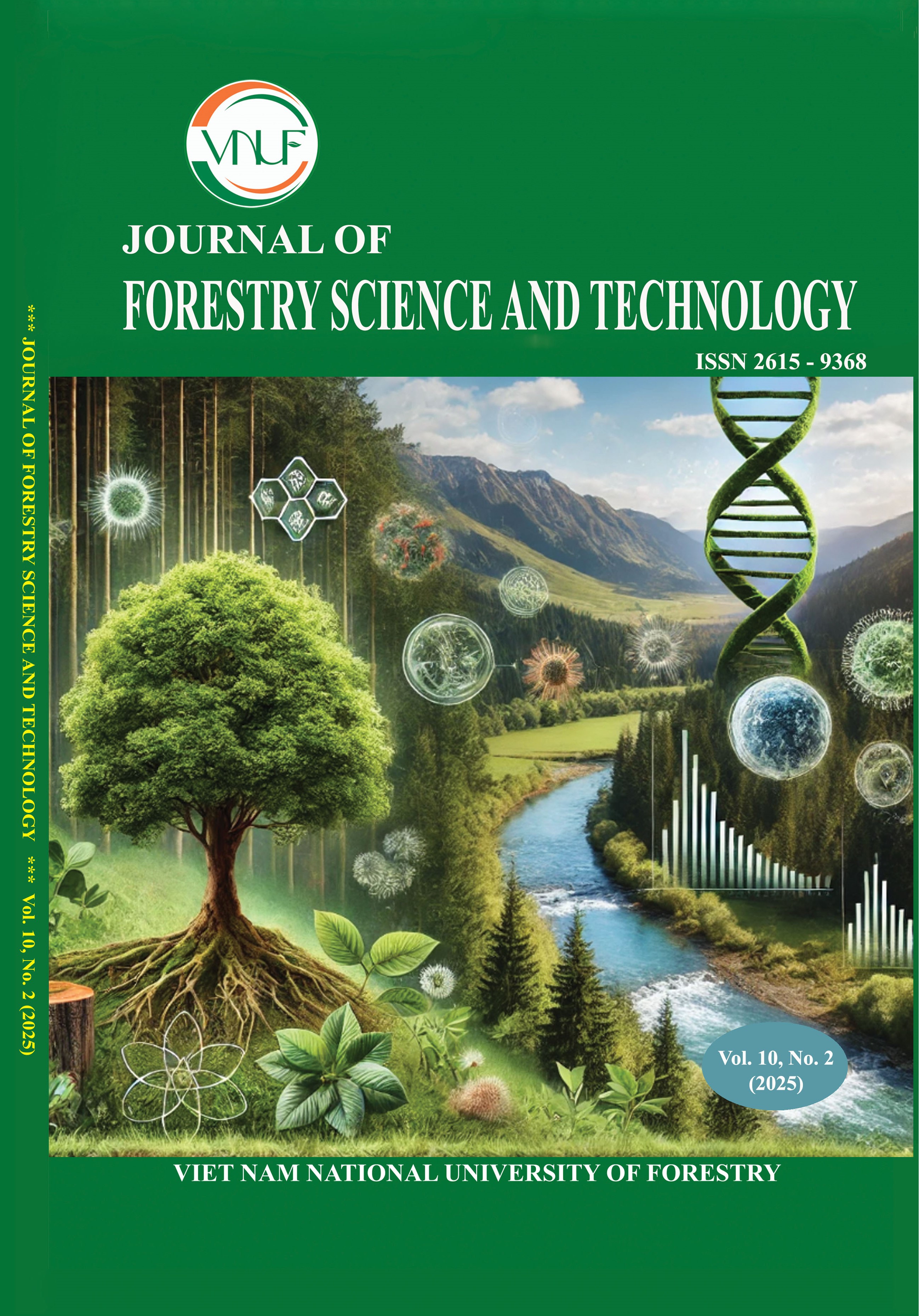Status of landslides and influencing factors in Bao Yen district, Lao Cai province and Quan Hoa district, Thanh Hoa province: A community-based survey
DOI:
https://doi.org/10.55250/Jo.vnuf.10.2.2025.061-071Keywords:
Bao Yen , community, impact factor, landslide, Quan HoaAbstract
This study aimed to evaluate the status of landslide incidents and the factors influencing them in two mountainous districts: Quan Hoa (Thanh Hoa province) and Bao Yen (Lao Cai province). The primary method was used by random interviews with selective sampling of local residents and officials in areas frequently affected by landslides. Additionally, the Analytic Hierarchy Process (AHP) method was employed to assess the importance of influencing factors. The main findings showed that in Quan Hoa, over the past five years from 2020 to 2024, there were 36 landslide incidents, occurring along road embankments, in areas with steep slopes, or regions lacking vegetation cover. Similarly, in Bao Yen district, 36 landslide incidents were recorded over the same period. The AHP analysis revealed the order of importance of factors affecting landslides in both areas, from most to least significant, as follows: heavy and prolonged rainfall (A, 42.7%), high and steep terrain (B, 25.0%), overexploitation of resources (C, 10.6%), low vegetation cover with weak soil protection (F, 7.0%), inappropriate agricultural practices (D, 5.7%), improper construction of infrastructure (E, 5.2%), and changing meteorological factors due to climate change (G, 3.7%). Based on these findings, existing local measures and community feedback, the study proposed a comprehensive set of solutions focusing on land management, resource mobilization, and infrastructure reinforcement to mitigate landslide risks and minimize their impacts in these high-vulnerability upland regions.
References
[1]. Disaster management policyand technology center. Retrieved from: http://www.dmc.gov.vn/thong-tin-thien-tai-pt32.html?lang=vi-VN.
[2]. D. J. Varnes (1984). Landslide hazard zonation: a review of principles and practice. Commission
on landslides of the IAEG. Nat. hazards. 3: 61.
[3]. M. J. Crozier (1986). Landslides: causes, consequences and environment, Croom Helm, London. Geogr. Phys. Quat. 7(1): 107–108.
[4]. S. Abuzied, S. Ibrahim, M. Kaiser & T. Saleem (2016). Geospatial susceptibility mapping of earthquake-induced landslides in Nuweiba area, Gulf of Aqaba, Egypt. J. Mt. Sci. 13(7): 1286–1303.
[5]. Doan Viet Long, Nguyen Chi Cong & Nguyen Quang Binh (2020). Assessment of the current situation and research solutions for landslides in Vietnam from 2010 to 2020. Journal of Science and Technology of Irrigation. 61: 119-128.
[6]. P. Reichenbach, M. Rossi, B. D. Malamud, M. Mihir & F. Guzzetti (2018). A review of statistically-based landslide susceptibility models. Earth-Science Rev. 180: 60–91.
[7]. A. Hansen (1984). Landslide hazard analysis. Slope Instab. 523–602.
[8]. A. Hansen, C. A. M. Franks, P. A. Kirk, A. J. Brimicombe & F. Tung (1995). Application of GIS to hazard assessment, with particular reference to landslides in Hong Kong. Geographical Information Systems in assessing natural hazards. 273-298.
[9]. R. K. Dahal, S. Hasegawa, A. Nonomura, M. Yamanaka, T. Masuda & K. Nishino (2008). GISbased weights-of-evidence modelling of rainfall-induced landslides in small catchments for landslide susceptibility mapping. Environ. Geol. 54(2): 311–324.
[10]. Lin Zhang, Zhengxi Guo, Shi Qi, Tianheng Zhao, Bingchen Wu & Peng Li (2024). Landslide susceptibility evaluation and determination of critical factors influencing andslides in the Qinghai-Tibet Plateau: A case study of Qinghai province, China. Ecological Indicators. Available at:
https://www.sciencedirect.com/science/article/pii/S1470160X24013682.
[11]. Zang Yeqi, Guo Yonggang, Wang Guowen & Wu Shengjie (2024). Evaluation of landslides susceptibility in Southeastern Tibet, China: An approach based on machine learning algorithms. Heliyon. Available at: https://www.sciencedirect.com/science/article/pii/S2405844024128319.
[12]. Thomas A. Stanley, Rachel B. Soobitsky, Pukar M. Amatya & Dalia B. Kirschbaum Landslide Hazard Is Projected to Increase Across High Mountain Asia. Earth's Future. 12(10): e2023EF004325.
DOI: 10.1029/2023EF004325.
[13]. Mohanty, M. Hussain, M. Mishra, D.B. Kattel & I. Pal (2019). Exploring community resilience and early warning solution for flash floods, debris flow and landslides in conflict prone villages of Badakhshan. International Journal of Disaster Risk Reduction. 33: 5-15.
[14]. X. Sun, G. Zhang, J. Wang, C. Li, S. Wu & Y. Li (2022). Spatiotemporal variation of flash floods in the Hengduan Mountains region affected by rainfall properties and land use. Nat. Hazards.
DOI: 10.1007/s11069-021-05061-5.
[15]. Hang Ha Chinh Luu, Quynh Duy Bui, Ngoc-Dung Luong, Dong Thanh Khuc, Hung Vu & Dinh Quoc Nguyen (2023). Flash flood and landslide susceptibility analysis for a mountainous roadway in Vietnam using spatial modeling. Quaternary Science Advances. 11: 100083.
[16]. Vo Nguyen Duc Phuoc, Nguyen Quang Binh, Pham Dinh Hung, Doan Viet Long & Nguyen Chi Cong (2019). Studies on the causes of landslides for mountainous regions in central region of Vietnam. Journal of Science and Technology. 17(12): 29-33.
[17]. Ninh Co (2023). Challenges in forecasting landslides and rocks. Nhân Dân Newspaper (People Newspaper) (https://nhandan.vn/thach-thuc-trong-du-bao-sat-lo-dat-da-post752589.html).









